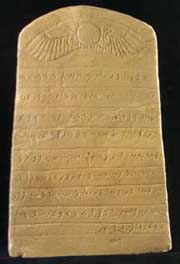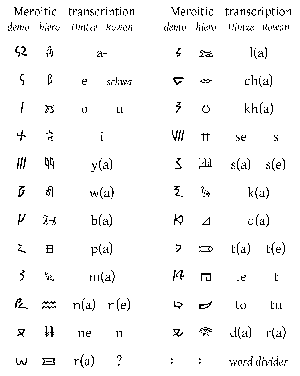WritingMeroitic
The earliest evidence found for the Meroitic writing dates back to the early second century BC. One of the biggest misconceptions is that Meroitic was similar to the language of classical Kush and Egypt. In an extensive research on Meroitic, two of the world's renouned experts of Meroitic, Claude Rilly and Alex de Voogt, conclude: "Whether cursive of hieroglyphic, the Meroitic script is not a system of consonants and ideographic signs as in Egyptian. Instead it is a syllabary with a default vowel /a/, also known for the Brahmi script in India, for instance"1 Meroitic is an alphasyllabic script,2 and is composed of twenty-three characters, four vowels, fifteen consonants, and four syllabus signs.3 In this system, every consonant has a presumed vowel. When writing consonants without vowels, the scribes used special signs. Both, the hieroglyphic and the cursive versions of Meroitic were read in the direction that the figures face. However, most of the cursive writings found were written from right to left, and the hieroglyphs from top to bottom. Words were uniquely separated by two or three dots. Examples of deciphered Meroitic words that are commonly found in Meroitic texts include qor for ruler, kdi for lady, ste for mother, and mk for god.4
Although the aspect of flexibility must have been a major advantage to the efficiency of the Meroitic script, it leads to significant difficulties when linguists attempt to decipher it. This is one reason the decipherment of Merotic remains a challenge. The problem is magnified by the fact that the script was not included in the Rosetta Stone; there is no direct comparable script to Meroitic. Perhaps the biggest question about Meroitic concerns its classification. While some scholars theorize that it is related to Berber,5 and other Afro-Asiatic languages, others suggest Eastern Sudanic.6 Affiliations between Meroitic and the Indo-European language family on one hand,7 and South Semitic on the other,8 are still debated by linguists. Understanding Meroitic would be of immense value to our knowledge of the Kushite civilization. Unfortunately, the scholarly efforts aimed at deciphering the script are not enough. Unless deciphered, our knowledge of the Kushite kingdom and its people will remain lacking. |
||
Edited: Feb. 2009. |

